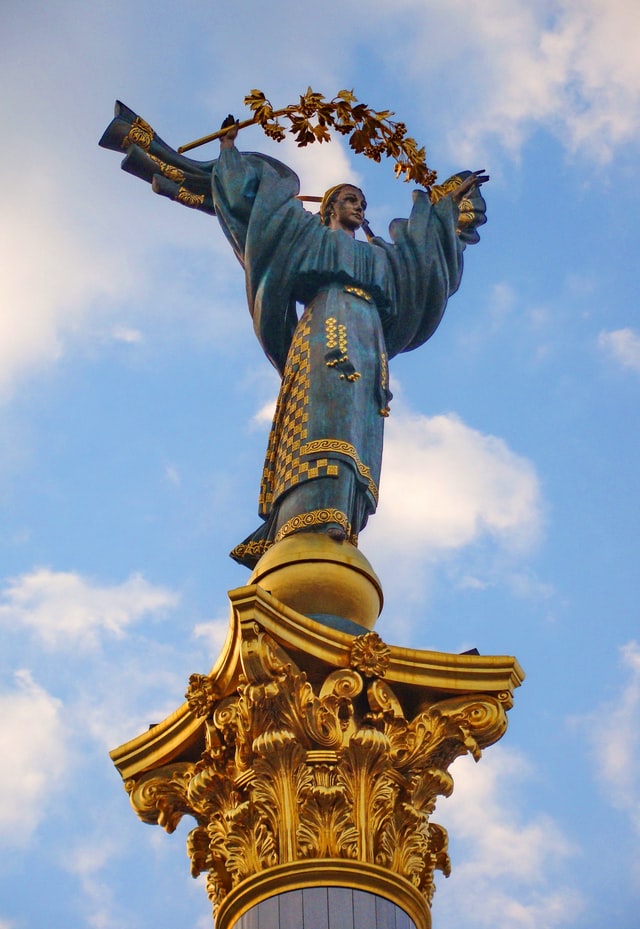A novel on tractors in Ukrainian is about anything but

Monument of Independence of Ukraine, sculpted by Anatoly Kushch in Kyiv. Photo by Volodymyr Tokar on Unsplash
Marina Lewycka’s 2005 debut novel, ‘A Short History of Tractors in Ukrainian’, was generally well-received when it appeared (I remember reading it with considerable pleasure), but panned by the great and the good in Ukraine.
Andrey Kurkov, a prominent Ukrainian writer who’s now being reverently quoted everywhere, reviewed Ms Lewycka’s debut book in The Guardian in withering terms. It’s a quite “banal tale”, he said, “of a Ukrainian woman who enters the UK on a tourist visa and who is prepared to go to any lengths to remain in the country.”
So there we have it.
A short history of tractors in Ukrainian is about anything but. In fact, it is about need, which drives everything really – even war.
Valentina, a buxom young Ukrainian immigrant, needs a British passport, for which she is prepared to marry 84-year-old Nikolai, a Ukrainian immigrant to Britain, whom she cares about not a jot.
Valentina also needs to provide an “oxfordcambridge education” for her teenage son, who has come with her to the UK.
Nikolai needs to play out a number of sexual fantasies, much beyond his physical capabilities.
Nikolai’s daughters, Nadezhda and Vera, need to show their concern for their father by much gnashing of teeth over the young blonde gold-digger.
Incidentally, Nikolai also feels he needs to leave a permanent mark on the world and so he’s trying to write a history of tractors in Ukrainian.
Mr Kurkov noted in his review that the characters in the novel suffer from their treatment at the hands of their creator.
“Just about everyone portrayed in it inspires the sympathy of the reader except the Ukrainians, legal and illegal,” the great Ukrainian writer complained. “What we see are caricatures.”
That sounds a tad arrogant. What might Mr Kurkov mean?
There is Valentina’s buxom form; the old man’s impotent instinct to constantly be in pyjamas or naked, occasionally inserting “a Ukrainian word into his English sentences” and his younger daughter Nadezhda’s reminiscing about Ukraine and tragic events such as the famine, Nazi occupation and Stalin’s purges.
There is the fact the daughters eventually manage to get their father divorced from his grasping young wife, even as Nadezhda learns about the Holodomor, the three-year Great Famine in Soviet Ukraine from 1932. It killed millions and Ukrainians correctly regard it as entirely man-made and deliberate. Again, there are echoes of the situation today.
Mr Kurkov, who belongs to a literary school that seeks subtlety rather than on-the-nose portrayals, writes: “Reading this novel gave me the impression that I had read a school textbook on Ukrainian history with one eye on an episode of Coronation Street.”
Some might say the daily news, as this horrific war grinds on, is no different in the way journalists are telling it.
Click here and here to read the first and second in this series.
Tomorrow: Marina Lewycka on the ambiguities of being Ukrainian
EXTRACT FROM ‘A SHORT HISTORY OF TRACTORS IN UKRAINIAN’:
“Ireland, like Ukraine, is a largely rural country which suffers from its proximity to a more powerful industrialised neighbour. Ireland’s contribution to the history of tractors is the genius engineer Harry Ferguson, who was born in 1884, near Belfast.
Ferguson was a clever and mischievous man, who also had a passion for aviation. It is said that he was the first man in Great Britain to build and fly his own aircraft in 1909. But he soon came to believe that improving efficiency of food production would be his unique service to mankind. Harry Ferguson’s first two-furrow plough was attached to the chassis of the Ford Model T car converted into a tractor, aptly named Eros. This plough was mounted on the rear of the tractor, and through ingenious use of balance springs it could be raised or lowered by the driver using a lever beside his seat. Ford, meanwhile, was developing its own tractors. The Ferguson design was more advanced, and made use of hydraulic linkage, but Ferguson knew that despite his engineering genius, he could not achieve his dream on his own. He needed a larger company to produce his design. So he made an informal agreement with Henry Ford, sealed only by a handshake. This Ford-Ferguson partnership gave to the world a new type of Fordson tractor far superior to any that had been known before, and the precursor of all modern-type tractors. However, this agreement by a handshake collapsed in 1947 when Henry Ford II took over the empire of his father, and started to produce a new Ford 8N tractor, using the Ferguson system. Ferguson’s open and cheerful nature was no match for the ruthless mentality of the American businessman. The matter was decided in court in 1951. Ferguson claimed $240 million, but was awarded only $9.25 million. Undaunted in spirit, Ferguson had a new idea. He approached the Standard Motor Company at Coventry with a plan, to adapt the Vanguard car for use as tractor. But this design had to be modified, because petrol was still rationed in the post-war period. The biggest challenge for Ferguson was the move from petrol-driven to diesel-driven engines and his success gave rise to the famous TE-20, of which more than half a million were built in the UK. Ferguson will be remembered for bringing together two great engineering stories of our time, the tractor and the family car, agriculture and transport, both of which have contributed so richly to the well-being of mankind.”

